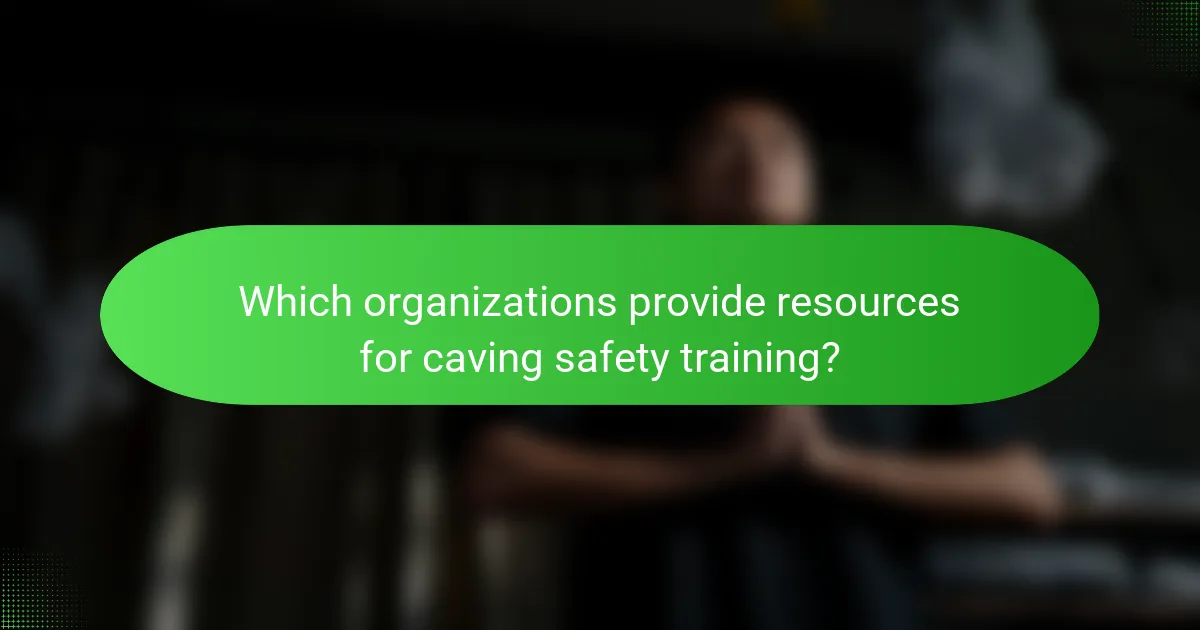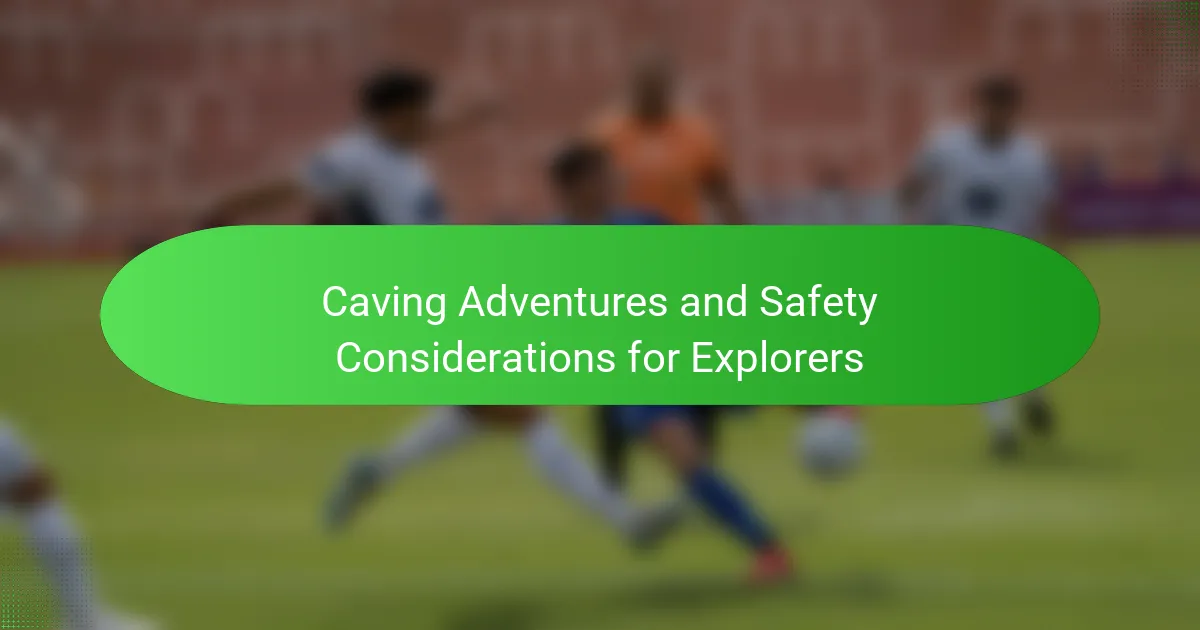Caving adventures offer unique experiences and challenges for explorers, but safety is paramount. Essential gear ensures protection and comfort. Awareness of primary risks like falls and hypothermia is crucial. Understanding cave environments influences exploration techniques, while best practices enhance navigation and safety. Organizations provide valuable resources for training and environmental preservation.

What essential gear is needed for caving adventures?
Essential gear for caving includes a helmet, headlamp, gloves, sturdy footwear, and appropriate clothing. Each item plays a critical role in ensuring safety and comfort during exploration. A helmet protects against falling debris, while a headlamp provides necessary illumination. Gloves offer grip and protect hands from sharp surfaces. Sturdy footwear prevents slips and injuries on uneven terrain. Lastly, wearing moisture-wicking and layered clothing helps regulate body temperature in varying cave conditions.
How does proper equipment enhance safety in caves?
Proper equipment significantly enhances safety in caves by providing essential support and protection. Quality gear, like helmets and harnesses, reduces injury risk during exploration. Proper lighting ensures visibility, preventing accidents in dark environments. Additionally, specialized clothing regulates body temperature, enhancing comfort and reducing hypothermia risks. Effective communication devices enable quick assistance in emergencies, further improving safety measures.
Which brands offer the best caving gear?
Several brands offer top-quality caving gear, including Black Diamond, Petzl, Mammut, and Wild Country. These brands are known for their durability, safety features, and innovative designs. Black Diamond is recognized for harnesses and helmets, while Petzl excels in headlamps and climbing gear. Mammut provides a range of ropes and protective equipment, and Wild Country is known for its climbing protection. Each brand has unique attributes that cater to different caving needs, ensuring explorers are well-equipped for their adventures.

What are the primary risks associated with caving?
Caving involves several primary risks that explorers should be aware of. These include falls, hypothermia, getting lost, and rock falls. Falls can occur due to slippery surfaces or unstable footing. Hypothermia is a significant risk in cold, damp environments, especially if explorers are unprepared. Getting lost can happen in complex cave systems, leading to panic and disorientation. Rock falls may occur due to loose stones or structural instability within the cave. Proper preparation and safety measures can mitigate these risks.
How can explorers prepare for emergency situations in caves?
Explorers can prepare for emergency situations in caves by carrying essential gear, developing skills, and establishing communication plans. Proper equipment includes helmets, headlamps, first-aid kits, and extra batteries. Training in navigation and rescue techniques enhances safety. Establishing a communication plan ensures timely assistance during emergencies.
What first aid skills are crucial for caving safety?
Essential first aid skills for caving safety include wound care, CPR, and managing fractures. Understanding these skills can significantly enhance safety during caving adventures.
Wound care involves cleaning and dressing injuries to prevent infection. CPR is crucial for responding to cardiac emergencies. Managing fractures includes immobilizing the injured area to avoid further harm.
Training in these skills can prepare explorers for potential accidents, ensuring a safer caving experience.

How do different cave environments affect exploration techniques?
Different cave environments significantly influence exploration techniques by dictating the tools and strategies used. For instance, wet caves require waterproof gear and specialized lighting, while dry caves may focus on dust management and rock climbing equipment. The complexity of cave systems also affects navigation methods, with intricate networks necessitating advanced mapping techniques. Additionally, temperature variations in caves can impact safety protocols, requiring explorers to prepare for extreme conditions. Understanding these factors is essential for ensuring safe and effective caving adventures.
What unique challenges do vertical caves present?
Vertical caves present unique challenges such as limited access, reduced light, and increased risk of rockfalls. These factors complicate navigation and safety for explorers. The vertical nature often requires specialized climbing gear and techniques, which can be unfamiliar to some cavers. Additionally, managing the psychological effects of height and confined spaces becomes crucial during exploration.
How do water-filled caves differ in exploration requirements?
Water-filled caves require specialized exploration techniques due to their unique challenges. These caves often necessitate scuba gear for underwater navigation, whereas dry caves typically only need basic caving equipment. Safety protocols differ significantly; explorers must be trained in diving and water safety to mitigate risks like drowning and hypothermia. Additionally, visibility in water-filled caves can be limited, requiring specific lighting equipment. Planning and experience are crucial for successful exploration in such environments, making them more demanding than traditional caving adventures.

What are the best practices for navigating caves safely?
To navigate caves safely, follow these best practices: always inform someone about your plans, wear appropriate gear, and carry essential equipment.
1. Plan your route and study cave maps.
2. Use proper lighting, such as headlamps and extra batteries.
3. Stay with your group and establish a buddy system.
4. Avoid touching cave formations to preserve the ecosystem.
5. Monitor your time to prevent getting lost.
6. Be aware of weather conditions that may affect cave access.
How can explorers effectively communicate underground?
Explorers can effectively communicate underground by using a combination of visual signals, sound cues, and technology. Hand signals can convey messages silently, while whistles or tapping on cave walls can alert nearby explorers. Two-way radios or walkie-talkies enhance communication, especially in larger caves. Establishing a clear system of signals before entering the cave is crucial for safety. Additionally, maintaining close proximity helps ensure messages are received promptly, reducing the risk of miscommunication in challenging environments.
What role does teamwork play in caving safety?
Teamwork is crucial for caving safety as it enhances communication, coordination, and risk management among explorers. A cohesive team can effectively share responsibilities, monitor each other’s well-being, and respond to emergencies. For instance, having designated roles—such as navigator, medic, and communicator—ensures that all aspects of safety are covered. Teams that work well together can assess hazards more accurately and make informed decisions quickly. This collaborative effort significantly reduces the likelihood of accidents and enhances the overall caving experience.

Which organizations provide resources for caving safety training?
Organizations that provide resources for caving safety training include the National Speleological Society, the Cave Research Foundation, and various local caving clubs. These entities offer courses, guidelines, and materials to enhance safety for explorers. They focus on skills such as navigation, emergency response, and equipment usage. Additionally, many organizations collaborate with experienced cavers to ensure comprehensive training programs.
How can local caving clubs enhance safety awareness?
Local caving clubs can enhance safety awareness through training programs, safety workshops, and regular communication. These initiatives build knowledge and skills among members, reducing risks during caving adventures.
Training programs teach essential techniques, such as proper gear usage and navigation skills. Safety workshops focus on emergency response and first aid, ensuring members are prepared for unexpected situations. Regular communication, including newsletters and meetings, keeps safety top of mind and encourages sharing of best practices.
By fostering a culture of safety, local caving clubs significantly contribute to the well-being of explorers in the field.
What certifications are available for caving explorers?
Various certifications are available for caving explorers, enhancing safety and skills. Key certifications include the National Speleological Society’s Cave Diver Certification, the American Caving Association’s Level 1 and Level 2 Caving Courses, and Wilderness First Aid Certification. These programs cover essential skills such as cave navigation, emergency response, and safety protocols. Additionally, some organizations offer specialized training for vertical caving and cave rescue techniques.

What are the environmental considerations for caving?
Caving can significantly impact the environment, requiring careful consideration. Key factors include ecosystem preservation, minimizing disturbance to wildlife, and managing waste effectively.
Explorers should prioritize using established trails to avoid damaging fragile cave formations. Additionally, understanding the local geology and hydrology is essential to prevent contamination of water sources. Proper gear and techniques can reduce physical impact on cave environments.
How does caving impact local ecosystems?
Caving can significantly impact local ecosystems through habitat disruption and species disturbance. The physical presence of cavers can lead to soil compaction, altered water drainage, and damage to delicate cave formations. Additionally, human activities may introduce pollutants or invasive species, threatening native flora and fauna. Protecting these ecosystems requires responsible exploration practices and adherence to conservation guidelines.
What steps can explorers take to minimize their footprint?
Explorers can minimize their footprint by following best practices in caving. First, plan trips carefully to avoid sensitive areas. Second, use established paths to prevent soil erosion. Third, pack out all waste, including food scraps. Fourth, avoid disturbing wildlife and natural formations. Lastly, educate fellow explorers on conservation efforts.

What are the psychological aspects of caving adventures?
Caving adventures positively affect psychological well-being by enhancing self-esteem, fostering teamwork, and reducing stress. Explorers often experience a sense of achievement and connection to nature. The unique environment of caves promotes mindfulness, as participants focus on their surroundings while navigating challenges. Engaging in caving can also improve problem-solving skills and resilience, contributing to overall mental health.
How can explorers manage fear and anxiety in confined spaces?
Explorers can manage fear and anxiety in confined spaces by employing various techniques. Breathing exercises help calm the mind and body. Visualization techniques allow individuals to imagine positive outcomes. Preparation through training enhances confidence. Establishing a support system among team members fosters reassurance. Practicing mindfulness can keep explorers grounded in the present moment.
What benefits does caving offer for mental well-being?
Caving offers numerous benefits for mental well-being, including stress reduction, enhanced mood, and increased focus. Exploring caves fosters a sense of adventure and accomplishment, which can boost self-esteem. The serene environment promotes mindfulness, allowing individuals to disconnect from daily stressors. Additionally, social interactions during group caving can strengthen relationships and provide emotional support.
What are common mistakes to avoid during caving adventures?
Common mistakes to avoid during caving adventures include inadequate preparation, neglecting safety gear, and failing to communicate. Explorers often underestimate cave conditions, leading to disorientation. Always bring proper equipment, including helmets and lights, and ensure all team members are briefed on the plan. Additionally, maintaining a buddy system enhances safety, as it ensures that no one is left behind.
What expert tips can enhance the caving experience?
To enhance the caving experience, prioritize safety, preparation, and awareness. Equip yourself with proper gear, including helmets, headlamps, and sturdy footwear. Familiarize yourself with the cave’s layout and potential hazards. Always travel with a knowledgeable guide and inform someone about your plans. Stay hydrated and maintain energy with snacks. Respect the cave environment by minimizing impact and avoiding disturbing wildlife.
